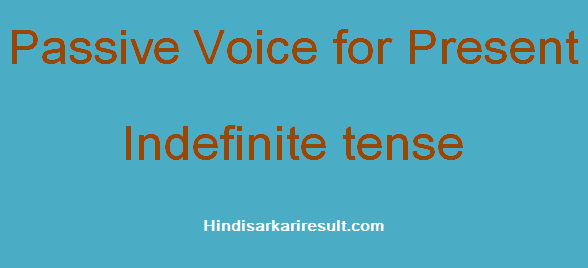
Passive Voice Present Indefinite Tense / Active and Passive Voice for Present Indefinite tense
Rules to change in passive voice for Present Indefinite tense
- For making Passive Voice of Present Indefinite Tense, we use helping verb ‘Is/Are/Am’ instead of ‘Do/Does’ with 3rd form of verb.
- Helping Verb in Passive Voice is used as per the Subject of the Passive Voice (Object of Active voice which becomes Subject of Passive Voice). If the Subject of Passive Voice is plural, Helping Verb of plurals will be used irrespective of the fact that in Active Voice, the subject was Singular.
- In case of Negative sentence, ‘Not’ is added after helping verbs and in case of Interrogative sentence helping verb comes in the starting of the sentence.
- In all types of sentences – Positive, Negative & Interrogative, 3rd form of verb is used in Passive Voice.
Present Indefinite Tense के sentences को Passive Voice में बदलने के लिए helping verb ‘Is/Are/Am’ के साथ verb की 3rd form का प्रयोग किया जाता है. Passive Voice Present Indefinite Tense
Rule: Present Indefinite Tense: Active to Passive Voice
| Type of Sentense | Sentence structure of Present Indefinite Tense: Active Voice | Sentence structure of Present Indefinite Tense: Passive Voice |
| Positive Sentences | Subject + Verb (Ist form) + s/es + Object + (.) | Convert Object to Subject + Is/Are/Am + Verb (3rd form) + By + Convert Subject to Object + Remaining + (.) |
| Negative Sentences | Subject + Do/Does + not + Verb (Ist form) + Object + (.) | Convert Object to Subject + Is/Are/Am + Not + Verb (3rd form) + By + Convert Subject to Object + Remaining + (.) |
| Interrogative Sentences | Do/Does + Subject + Verb (Ist form) + Object + (?) | Is/Are/Am + Convert Object to Subject + Verb (3rd form) + By + Convert Subject to Object + Remaining + (?) |
Active and Passive Voice Example for Present Indefinite Tense
| Active Voice | Passive Voice |
| Do you read my blog? क्या तुम मेरा ब्लॉग पढ़ते हो? | Is my blog read by you? क्या मेरा ब्लॉग तुम्हारे द्वारा पढ़ा जाता है? |
| Rohan loves Mona. रोहन मोना से प्यार करता है | Mona is loved by Rohan. मोना को रोहन के द्वारा प्यार किया जाता है |
| He drives my car. वह मेरी कार चलाता है | My car is driven by him. मेरी कार उसके द्वारा चलाई जाती है. |
| The teacher teaches students every day. अध्यापक विद्यार्थियों को रोज पढ़ाता है. | Students are taught by teacher every day. विद्यार्थियों को अध्यापक द्वारा रोज पढ़ाया जाता है. |
| Do you know him? क्या तुम उसे जानते हो? | Is he known by you? क्या वह तुम्हारे द्वारा जाना जाता है? |
| Teachers do not punish students now-a-days. अध्यापक आजकल विद्यार्थियों को सजा नहीं देते हैं | Students are not punished by teachers now-a-days. विद्यार्थियों को आजकल अध्यापकों द्वारा सजा नहीं दी जाती है. |
| She gives her books to the poor boy. वह अपनी किताबें गरीब लड़के को देती है | The poor boy is given books by her. गरीब लडक को उसके द्वारा किताबें दी जाती हैं. |
| Rahul does not like my advice. राहुल मेरी सलाह पसंद नहीं करता है | My advice is not liked by Rahul. मेरी सलाह राहुल के द्वारा पसंद की जाती है. |
| Do they require my help in emergency? क्या वे इमरजेंसी में मेरी सहायता चाहते हैं. | Is my help required by them in emergency? क्या मेरी सहायता इमरजेंसी में उनके द्वारा चाही जाती है. |
| Reema gives food to the beggar. रीमा भिखारी को खाना देती है. | The beggar is given food by Reema. भिखारी को खाना रीमा द्वारा दिया जाता है. |
| Reema gives food to the beggar. रीमा भिखारी को खाना देती है. | The food is given to the beggar by Reema. खाना भिखारी को रीमा द्वारा दिया जाता है. |
Note:
You can see in the last 2 examples when there are two Objects in the sentence, we can convert any Object to Subject. For ease, please convert the Object to Subject, which is coming just after the Verb. Or you may convert the Object to Subject which you want to emphasize more.
आखिरी दो उदाहरण में आप देख सकते हैं कि जब दो object हों तो हम किसी भी object को subject बना सकते हैं. आसानी के लिए आप verb के एकदम बाद वाले object को subject बना सकते हैं या आप उस object को subject बना सकते हैं जिस पर ज्यादा जोर देना चाहते हैं. Passive Voice Present Indefinite Tense

Nice
✍🏻✍🏻😍
Thanks for reading. Share this blog with your friends also.
Nice sir